WEDNESDAY
OCTOBER 31 - 2012
Grey
Phalarope
No chance of getting
out birdwatching today with nasty wet and windy
weather.
Tom Bickerton sent me
a photo of a Grey Phalarope, which he had the good
fortune to see at Hayling Oysterbeds on Oct 27. He
apologised for the blurry photo due to his using Chris
Cockburn's camera and his shaky hand.
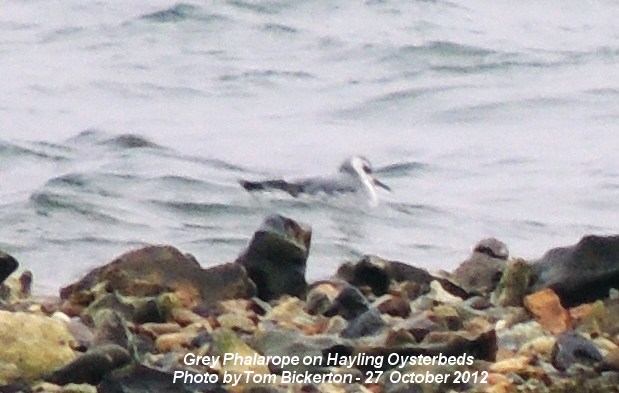
As far as I am aware
this particular bird has not been sighted again.
However, there has been one showing well at Pennington
Marsh in the west of the county over the past few
days.
Grey Phalarope is a
very scarce autumn and winter visitor to our area,
usually occurring after gales, which was probably the
case with this one. The last one we had locally was on
the shore at Prinsted on 16-17 September 2011
photographed by Tony Wootton, Richard Somerscocks and
no doubt many others. Here is Tony's photo, taken in
more favourable circumstances than Tom's, of what
looks like a 1st winter bird.
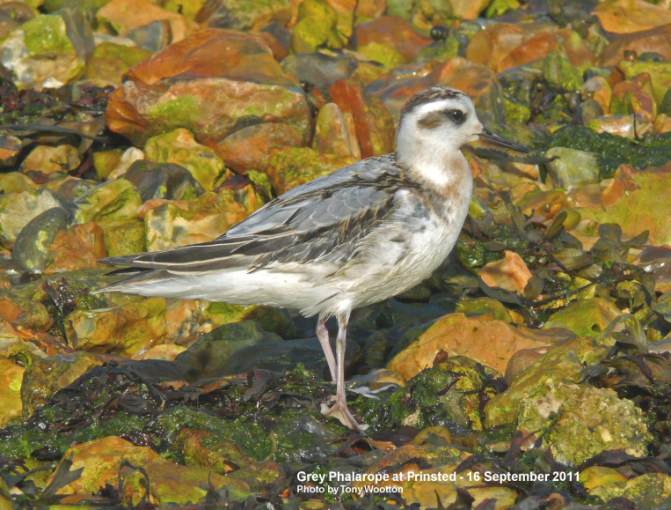
TUESDAY
OCTOBER 30 - 2012
NORE
BARN
14:00 - 15:00 - About
2-3 hours after high water.
Spotted
Redshank and Greenshank
The Spotted Redshank
was already present in the stream with the Little
Egret when I arrived, even though the tide was still
quite high. At about 14:15, a Black-headed Gull chased
the Spotted Redshank, which went hurtling off over the
saltmarshes with the gull in hot pursuit. I have no
idea what prompted this behaviour, which I have not
witnessed before.
However, the Spotshank
did not go far and I found it a few minutes later on
the shore by the woods. It was joined there by a
Common Redshank, which prompted the Spotshank to do
some chasing of its own and eventually the Common
Redshank flew off to the far saltmarshes. The Spotted
Redshank gradually made its way along the shore to the
main stream which was by this time emptying fast and
for the next 15 minutes or so it was feeding actively
in the clear waters of the stream with its companion,
the Greenshank.
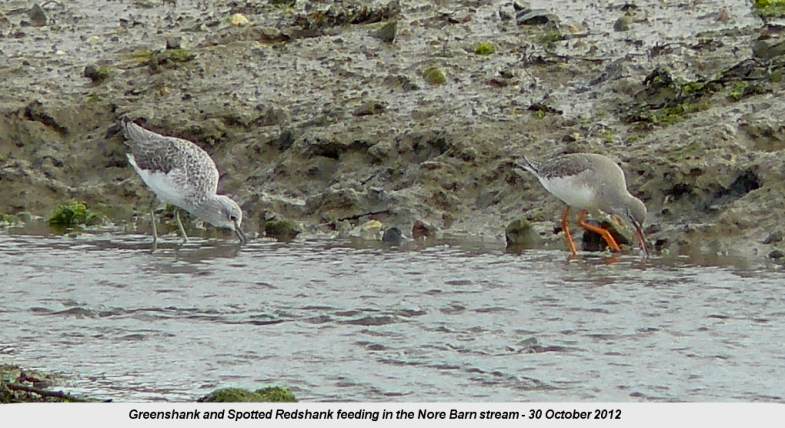
More
news about the Spotted Redshank is on a dedicated page
on this site . . . Spotted
Redshank
Brent
Geese
I counted a total of
102 Brent Geese on the western mudflats with three
families of 2, 2 and 1 juveniles. These seem to be the
'resident' families in Emsworth Harbour. So far I have
aged 328 Brent Geese finding 14 juveniles - ie 4.27%.
However, this figure probably overestimates the actual
proportion of juveniles in that some will have been
counted more than once.
A pair of Mute Swans
was in the stream as they were yesterday, but without
their brood of 4 cygnets.
BROOK
MEADOW
Malcolm Phillips went
round the meadow between 11.30 and 1pm today. From the
north bridge he spotted a Water Vole on the west bank
and near the south bridge he saw a Grey
Wagtail. This was only the second sighting of Grey
Wagtail on Brook Meadow this year. They are scarcer
than usual. Going back by Peter Pond Malcolm saw a
male Common Darter Dragonfly.
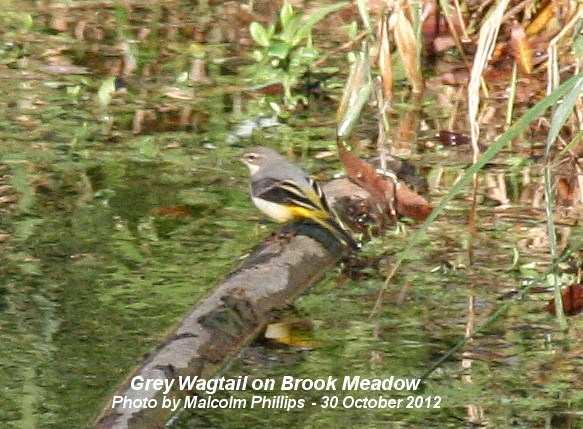
FINDHORN
GODWITS
Regarding the
colour-ringed Black-tailed Godwit WN+OY flag that
Richard Somerscocks photographed in Findhorn bay
yesterday, Pete Potts reported that they ringed it as
a chick, one of a brood of 3, this summer in north
Iceland on 10th July 2012
MONDAY
OCTOBER 29 - 2012
NORE
BARN
13:30 - 14:30 - Tide
falling. About 3 hours after high water.
What
I assume was the regular Spotted Redshank arrived with
its usual 'chu-wit' greeting call at 13:30.
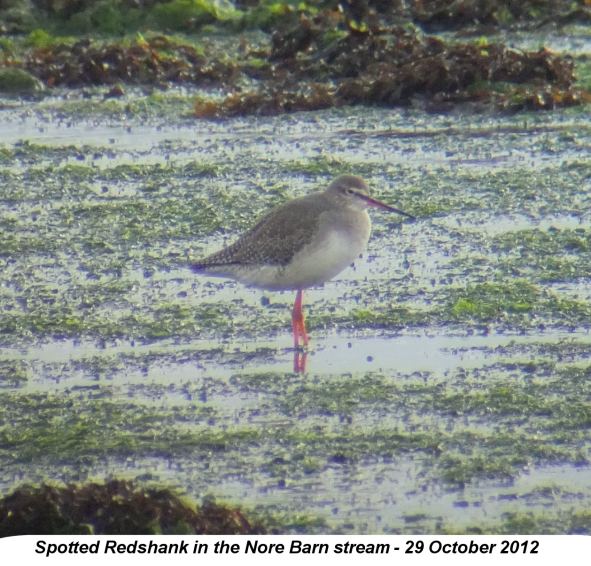
The Greenshank and the
Little Egret came in about 13:45 and all three fed in
the stream as the tide gradually ebbed. A small flock
of 9 Black-tailed Godwits also arrived and settled on
the shore in the lower stream - no colour-rings.
Also,
in the stream was a family of Mute Swans of two adults
and four cygnets.
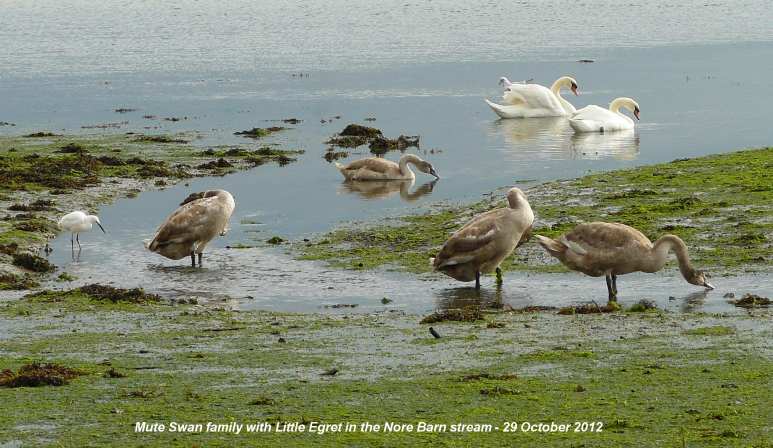
By 14:15 the stream
was fairly empty of tidal water and the Spotted
Redshank and Greenshank were feeding in the lower
stream where it merges into the main harbour.
I had almost given up
on a second Spotted Redshank, when it suddenly turned
up and was immediately 'greeted' by the first Spotted
Redshank, ie it approached it and came quite close. I
could then see quite clearly that the new arrival had
darker legs than the original one. The original
pale-legged Spotted Redshank also spent some time
chasing the new arrival in a rather half-hearted
fashion, suggesting it was his territory!
Sorry
about the quality of this digiscoped photo. The pale
legged Spotted Redshank is on the right

It is not easy to
compare photographs from different days, as the light
varies such a lot and my camera is not all that great.
However, I don't think any of the photos show the
regular Nore Barn bird's legs as dark as those of the
new arrival. Today's observations convinces me that
the regular Nore Barn Spotshank is the one with pale
legs. The dark legs on the other bird might be part of
its breeding colouration not yet worn away. Pete Potts
thought the pale legs might mean it was a juvenile,
but there is no other obvious plumage difference
between the two birds to justify that conclusion.
For
all the Spotted Redshank news go to . . .
Spotted
Redshank
OTHER
NEWS
Mystery
fungi
There is a cluster of
fungi growing at the base of one of the large Crack
Willow trees alongside the path through Palmer's Road
Copse. The caps are red and sticky, the stems white
with brown spots and the gills white. They look a bit
like one of the fungi that Derek Mills photographed
during the Havant Wildlife Group visit to Havant
Thicket on Oct 27 that Ralph Hollins thinks is
Cortinarius snaguineus (Bloodred Webcap). However, the
red gills of that fungus rules it out.
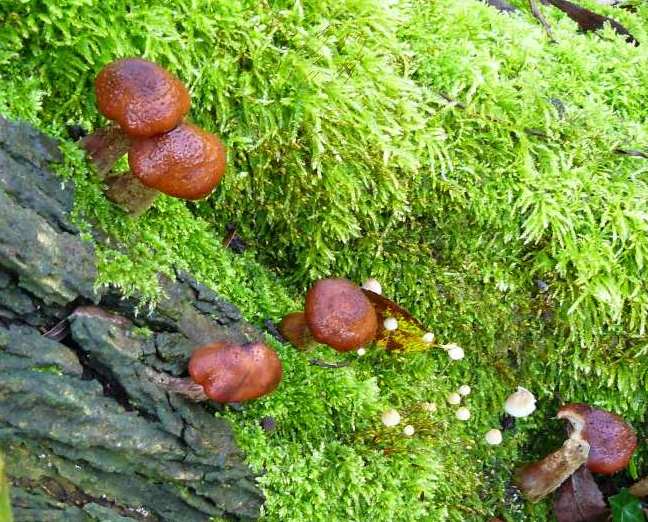
My very tentative
guess is Tricholoma ustale (Burnt Knight). From
the Hampshire Fungus Recording Group web site this
fungus is widespread in the New Forest with the
nearest record in Havant. See. . http://www.hampshirefungi.org.uk/fungi.php?name=ustale#maptxt
Great
Black-backed Gull
An adult Great
Black-backed Gull was on the south raft on Slipper
Millpond this morning. Tom Bickerton writes: "it is
going to be interesting if the 2 juveniles are allowed
on the pond next year. The two adults must be the most
laid-back gull parents I've come across, so I wouldn't
put it past them".
Brent
Goose productivity
Tom Bickerton did the
South Hayling WeBS on Oct 27 (that's the one I did for
about 20 years). He found a total of 247 Brent Geese
with only one family with 2 juveniles. The WeBS count
at West Wittering on Oct 27 recorded a flock of 1160
Brent of which only 14 were young. So, this looks like
another bleak breeding season for the Brents.
GODWIT
NEWS FROM FINDHORN BAY
Richard Somerscocks
sends an update on Black-tailed Godwits from Findhorn
Bay in Scotland.
"Overall, we do not
have the numbers of Black-tailed Godwits that you see
in Chichester Harbour. The most I have seen this
season is around 15. Local birdwathchers say that it
is unusual to see many at all over the winter - the
more common variety is the Bar-tailed which we see in
greater numbers.
However, over the last
few days I have been watching a group of 4-6
Black-tailed Godwits in one particular area of
Findhorn Bay and on checking today I found their
numbers had increased to 12 and included for the first
time a colour ringed bird. It was WN+OY flag and was
seen in this group at location NJ055620 at 15:00 today
29 Oct 12. Given that it had a yellow flag I was
wondering whether it was an Icelandic bird ringed by
Pete."
Here
is Richard's photo of a few of the Godwits with the
colour-ringed one on the right.
They all look like juveniles to me from the cinnamon
mottled plumage on their backs
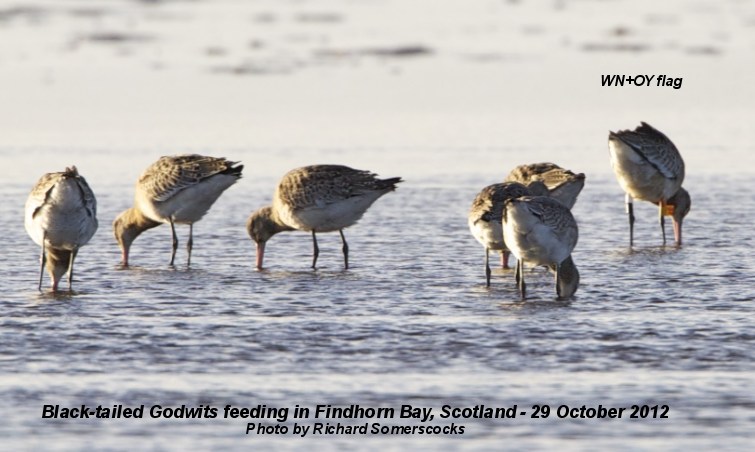
For
all the local Black-tailed Godwit news go to . .
. Black-tailed
Godwits
SUNDAY
OCTOBER 28 - 2012
NORE
BARN
13:30 - About 3 hours
after high water. The stream was already quite empty
when I arrived, though the mudflats were still covered
in water.
Two
Spotted Redshanks
As yesterday, two
Spotted Redshanks were feeding in the lower stream
with a Greenshank. However, unlike yesterday when one
of the Spotshanks was colour-ringed W+GY, today both
birds were unringed. So, clearly, we have at least
three Spotted Redshanks in the area, one ringed and
two unringed. The two unringed birds presumably
includes the regular Nore Barn bird. I was surprised
to see the two Spotted Redshanks feeding so close
together, almost snuggling up at times, or so it
seemed.
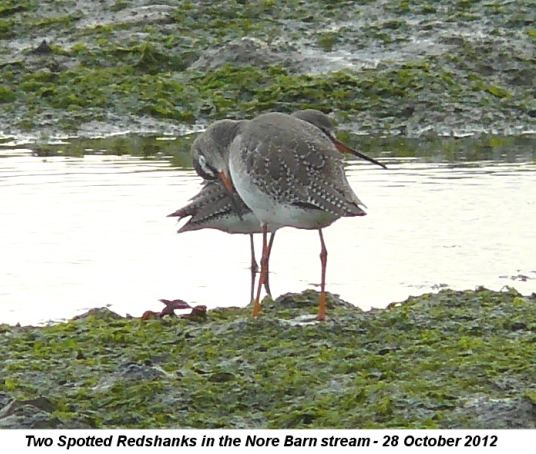
I met up with a
visiting birdwatcher who had travelled down from
Woking to see the Spotted Redshanks in the stream. He
was suitably impressed with the great view of the two
Spotted Redshanks with the Greenshank; hopefully he
got some good photos as did I.

I was interested to
see from my photos that the leg colours of the two
birds differed slightly, one being a much lighter red,
almost orange, not unlike that of the Common Redshank
while the other was a dark red. This could be an
artefact of the camera, though the Birds of the
Western Palearctic states that Spotted Redshank legs
and feet are black-red when breeding and at other
seasons darker red than Common Redshank, only rarely
orange.
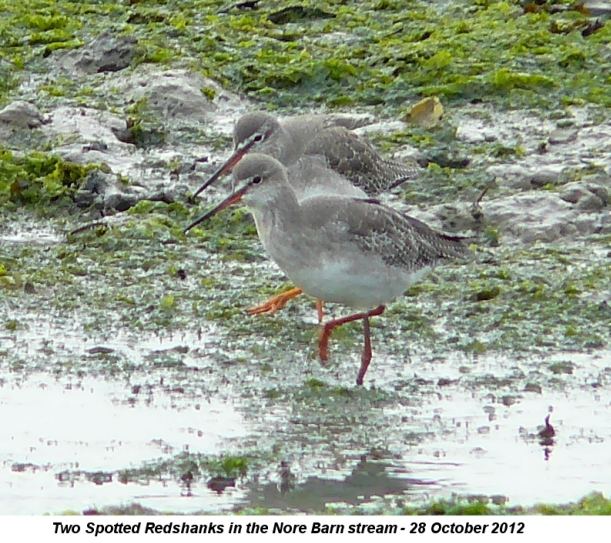
For
all the Spotted Redshank news go to . . .
Spotted
Redshank
Other
birds
Wigeon - up to 36 at
Nore Barn.
Black-tailed Godwits -
just 29, but no colour-rings.
Brent Geese - up to
118 on the western mudflats at the end of Kings Road
with just one family of two juveniles. This is
probably the same family that I have seen here before.
It looks as if Chris Cockburn was right when he said
this looks like a poor breeding season for Brents.
GARDEN
BIRDS
Great
Spotted Woodpecker
Patrick Murphy had a
long visit from a Great Spotted Woodpecker to his
garden yesterday afternoon. The bird spent some time
having a good feed on the fatball, giving Patrick a
splendid opportunity to get some nice photos. Here is
one he sent me.
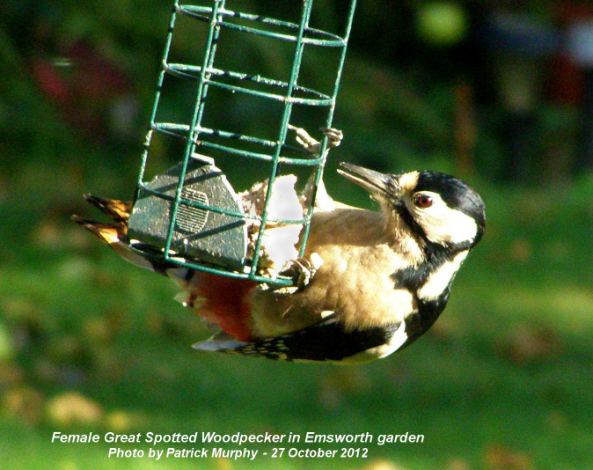
The Great Spotted
Woodpecker is not all that uncommon in gardens. BTO
figures indicate it was seen in 28.5% of gardens
taking part in the Garden BirdWatch survey in this
period of the year and is currently standing 16th in
the overall rankings of garden birds. They are found
more commonly in rural than in suburban gardens,
consistent with their woodland roots. Increased
prevalence of this species in gardens has been
mirrored in the wider UK population where there has
been a large increase.
Great Spotted
Woodpecker is a rarity in my garden, which is closer
into town than Patrick's; the last one was 4 years
ago. Well, it was until today! Immediately after I had
written this in my blog, I sat down in the back room
with a coffee overlooking the garden and to my
astonishment in came a female Great Spotted Woodpecker
just like Patrick had. It was here for no longer than
30 seconds, and I did not have time to get my camera
out.
It searched around the
feeders which I have hanging from the flowering cherry
tree, though there were no fatballs or peanuts. I have
dug out a photo I took of a juvenile Great Spotted
Woodpecker with a completely red crown (the adult
male has red restricted to the nape) I had in the
garden of the summer of 2008 shows it atempting to
feed from the feeder containing sunflower hearts.
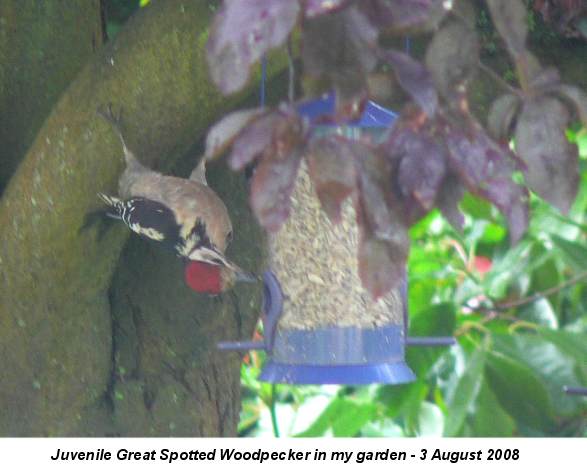
Garden
birds return
After several weeks
(or possibly months) with very few birds in the garden
it looks as if the cold weather has prompted a return.
During an hour's watch this morning I saw 10 species
including the female Great Spotted Woodpecker
described already. There were Blue Tit 2, Robin 1,
Blackbird 2, Starling (a very rare visitor) 1,
Chaffinch 2, Greenfinch 4 (including one juvenile),
Collared Dove 2, Goldfinch 10, Woodpigeon 3 and Great
Spotted Woodpecker 1.
Grey
Squirrels
BTO also reported an
increase in Grey Squirrel in gardens (see yesterday's
blog entry). Patrick Murphy is having an ongoing
battle with a local squirrel. Here is Patrick's photo
taken this morning of the squirrel "attacking" a new
"squirrel-proof" seed feeder. I also had one in my
garden this morning, not attacking the feeders, but
taking nuts from the table and burying them!
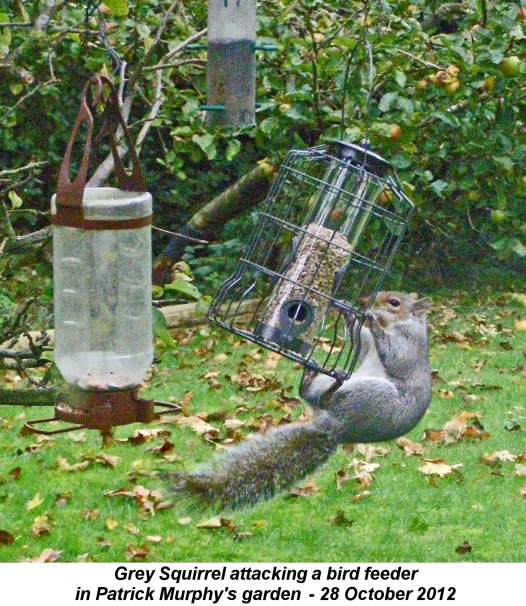
FUNGUS
IDENTIFICATION
Regarding the fungi
shown in yesterday's blog, Ralph Hollins provides some
useful web site links for identification.
1. Roger Phillips
online identification website. I have only just come
across it and found it useful. To identify any fungus
that you come across try starting with
http://www.rogersmushrooms.com/gallery/visualkey.asp
which takes you to the first of three pages on which
you can select the image which seems closest to your
find, click the name associated with that image and
that takes you to a gallery of photos illustrating the
species in that group, click the photo most like your
find and you will get more info and the vital
statistics that will confirm or deny that this is your
find - if your first choice is not right go back to
the gallery and try again!
2. Another useful
online website is http://www.hampshirefungi.org.uk/fungi.php
- put a name in the search box to get a map of where
it has been found in Hampshire The new English Names
devised by the British Mycological Society can be seen
at http://www.britmycolsoc.org.uk/library/english-names/
(at the top of that page is a link to download the
list as a pdf )
SATURDAY
OCTOBER 27 - 2012
NORE
BARN
13:30 - 14:30 - About
3-4 hours after high water at 10:34 at height 4.7.
There was an amazing
gathering of waders in the lower stream when I arrived
including two Spotted Redshanks, a Greenshank and a
good flock of Black-tailed Godwits. I suspect they
were sheltering from the very cold north wind.
I was pleased to meet
up with John Hilton from Winchester. John e-mailed me
on several occasions about the best time to see the
Spotted Redshank. Well, he certainly choose the right
day to visit, though he was disappointed that the
conditions were not good for photography.
Two
Spotted Redshanks
This was my first
sighting of two Spotted Redshanks in the stream this
season. It is not unusual for two to turn up, for I
have another 26 double sightings on record since 2004
and 5 triple sightings. The two birds were fairly
close together in the lower stream when I arrived, but
subsequently separated as the tide fell. The low sun
meant that conditions were not favourable for taking
photos. This is the best one I could manage showing
the two birds together.
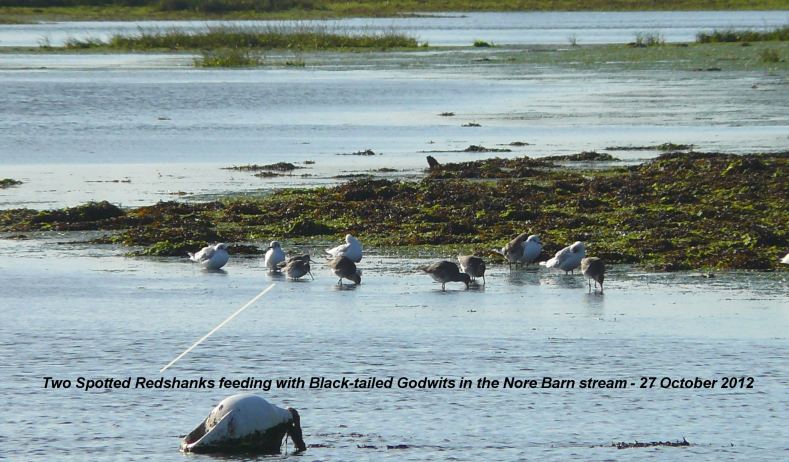
I am fairly sure that
one of the Spotted Redshanks was the regular Nore Barn
bird. The other one was the colour-ringed bird
W+GY - ringed on Thorney 16th October 2008 by
Pete Potts and his team. It has been regularly seen in
the Thorney-Nutbourne area in the autumn-winter period
ever since. We have had only one previous sighting of
it in Emsworth Harbour on 24-Oct-11 by Richard
Somerscocks.
For
all the Spotted Redshank news go to . . .
Spotted
Redshank
Black-tailed
Godwits
I counted 84
Black-tailed Godwits in the flock near the stream,
which is the most I have seen in this area this
autumn. I checked most of them for colour-rings, but
the strong sun made it impossible to read the
combinations with any confidence.
Peregrine
A couple of
birdwatchers who were passing told me they had just
seen a Peregrine chasing and catching a Starling over
by Nore Barn Woods. About 20 minutes later I was
talking with another two visiting birdwatchers when we
noticed all the waders go up. One of the visitors
pointed out a Peregrine flying east towards the main
harbour, probably the same bird that had been seen a
little earlier.
Sandwich
Tern
Annoyingly, I had just
focussed my scope and camera on a Sandwich Tern
perched on an offshore buoy when the Peregrine passed
over and everything went up including the tern. This
is likely to be a wintering bird as the mass of
migrants have left.
Brent
Geese
I counted 62 Brent
Geese on the western mudflats. I did not see any
juveniles.
HAVANT
THICKET
Heather Mills reports
on this morning's walk by the Havant Wildlife Group in
Havant Thicket
12 enthusiasts met on
a chilly but fine morning at Havant Thicket. Beryl
also arrived but only to say cheerio, as she was off
to South Africa to holiday. Unfortunately Rosie was
not around to give us her expertise in fungi I.D. but
Jim pointed us in the right direction with the aid of
a few books which we had brought along. Not many birds
but some did get a glimpse of & hear a male
Bullfinch, with a couple of others. Coal tit, along
with blue and long tails.
Good morning for fungi
as we expected. The most prolific fungi being the
Amethyst deceivers. Fly agaric, candle snuff, yellow
stag's horn, common earthball, sulphur tuft, a
toughshank of some kind and a good few others not
identified. The beech wood to the right of the
footpath on our return journey had the most diverse
fungi, which Derek captured some for your perusal.
Nothing out of the ordinary I suspect. Tormentil,
clover, Stitchwort, cutleaf Cranesbill & gorse,
with cross leaved heath. in flower.
Here
are just three of the fungus photos sent by Heather.
Any offers for IDs?

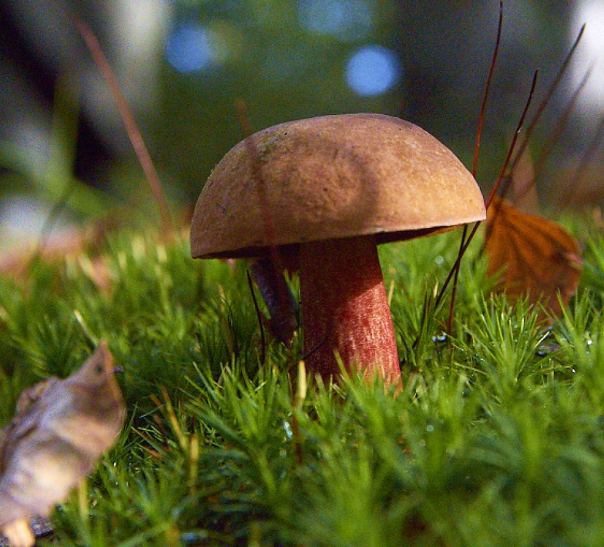
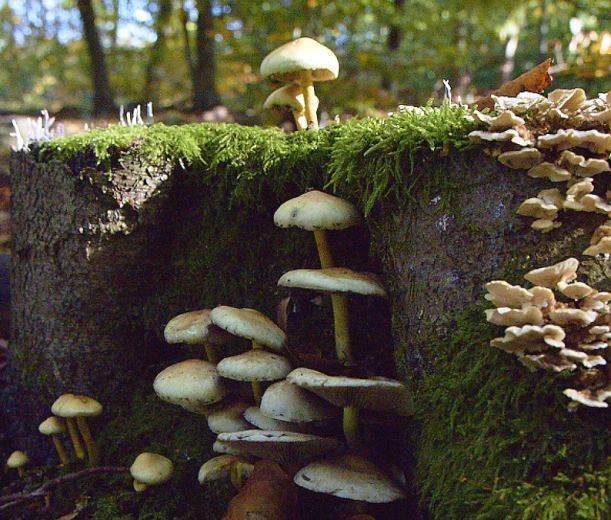
OTHER
NEWS
Fish
in Westbrook Stream
I met a couple of lads
looking at the Westbrook Stream this morning. They
said they had seen a Flounder and a Brown Trout. These
are firsts for this wayside. The Flouder must have
come in on the high tide.
Marsh
Harrier on Thorney
A fem/imm Marsh
Harrier was seen 2.30 on Thursday afternoon (Oct 25)
over Thorney Deeps - reported on SOS Sightings.
BTO
REPORTS
Food
caching in gardens
In gardens Coal Tit,
Jay and Nuthatch have spent much of October caching
food for winter. Coal Tits, in particular, have caught
the eye, gathering food from feeding stations and
stashing it in all sorts of nooks and crannies. How
good are they at remembering where they have stored
their food? Recently, I have also witnessed a Grey
Squirrel doing exactly this in my garden for the first
time.
Grey
Squirrels invade gardens
It's not just birds
that turn to garden feeders during autumn, Grey
Squirrels also get in on the action. Garden BirdWatch
data indicate that Grey Squirrels have been
particularly abundant in gardens this year. See the
big increase in reporting rate on the following link.
http://bto-enews.org/NXK-10KUS-3UEDCR-EB3IJ-0/c.aspx
Bullfinches
record
Record numbers of
Bullfinches have been coming to garden feeding
stations, Garden Bird Feeding Survey . . .
http://bto-enews.org/NXK-10KUS-3UEDCR-E860P-0/c.aspx
Thrush
migration
Over the last few days
one of the biggest natural events of the autumn has
been unfolding along the east coast with the arrival
of hundreds of thousands of winter thrushes. By far
the biggest arrival occurred at Spurn, East Yorkshire
where over 21,000 Redwing, 10,000
Blackbird, 9,000 Fieldfare, 800 Song
Thrush, 57 Ring Ouzel and 10 Mistle
Thrush were counted on the 22nd. Until then
Fieldfares were conspicuous by their absence and the
BirdTrack reporting rate shows just how late they are
arriving this autumn, in comparison to the previous
two years. Starlings also began moving this
week with over 5,000 being counted moving west on the
North Norfolk coast on the 20th, and around 30
Waxwings have arrived in the north.
Keep abreast of the
latest comings and goings through the BTO Bird
Migration Blog . . . http://bto-enews.org/NXK-10KUS-3UEDCR-E860U-0/c.aspx
THURSDAY
OCTOBER 25 - 2012
EMSWORTH
HARBOUR
Nore
Barn stream
11:00 -12:00 The tide
was still well in when I arrived at Nore Barn. I
watched the stream gradually empty over the next hour
by which time the Little Egret, Greenshank and Spotted
Redshank arrived in that order at about 15 minutes
intervals.
One of my Greenshank
photos shows it apparently spurting out water from its
bill. I have peviously seen this behaviour mostly in
Black-tailed Godwits, though I have photos of
Greenshank doing it as well. The behaviour has
continued to baffle the experts as to its explanation.
For more details see . . . Godwits
spurting
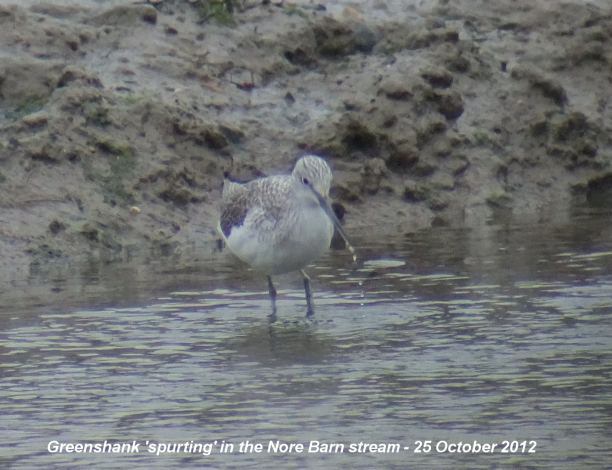
During that time a
couple of people stopped for a chat. First, my friend
Sid Davies and then Stephanie Williamson (of Pesticide
Action Network). Stephanie was just in time to see the
arrival of the famed Spotted Redshank at 12 noon. The
birds did not remain long in the stream, as the tide
fell quickly, but moved further out into the main
harbour.
Brent
Geese
12:00 - 12:30 - I
walked along Western Parade towards the Emsworth. I
had noticed small groups of Brent Geese flying in from
the west. A flock of 41 geese had settled on the
mudflats to the west of the Emsworth Sailing Club and
I was able to go through them carefully for juveniles.
There were four families of broods of 2, 2, 2 and 1.
Two
families each with two youngsters are shown in this
photo

The presence of such a
good number of juveniles is surprising in view of
Chris Cockburn's pessimism about this year's Brent
productivity at last night's Hampshire Wildlife Trust
talk at Warblington School. Chris counted 1,500 Brents
in Langstone Harbour and found only 7 juveniles among
them. However, I suspect my figures could be biased as
families tend to gather in small harbours like
Emsworth, well away from the large flocks that Chris
deals with.
Black-tailed
Godwits
I could see a good
gathering of around 100 Black-tailed Godwits on the
edge of the saltmarshes, but they were too far away to
read colour-rings.
OTHER
NEWS
Juvenile
Herring Gull
I cycled down to
Thorney Great Deeps yesterday and found an immature
gull perched on a post just before I got to the deeps.
As I was watching it and taking some photos, it was
joined by an adult Herring Gull and they flew off
together. This confirmed my suspicion that it was a
juvenile Herring Gull. My Collins Bird Guide indicated
that Herring Gull has what it calls four age groups
depending on plumage. My guess is that this bird was a
1st winter bird. Its bill is still completely black (a
2nd winter would have a pink base) and has barred or
notched scapulars (a 2nd winter would have more of a
clean grey back).
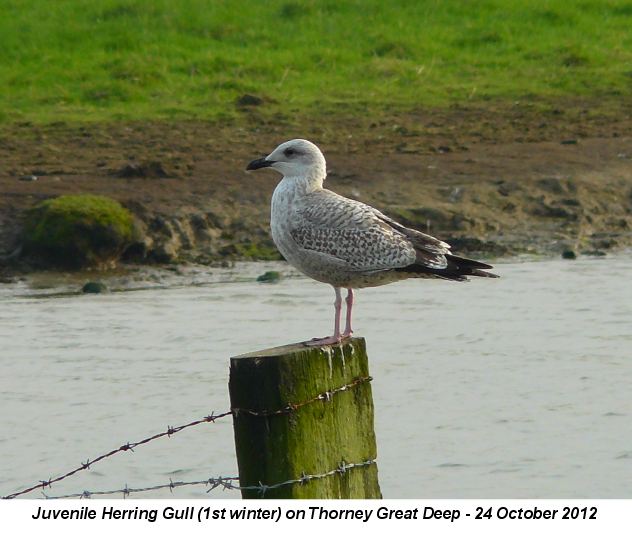
WEDNESDAY
OCTOBER 24 - 2012
EMSWORTH
HARBOUR (east)
11:30 - 12:30 - Low
water. I counted 46 Brent Geese on the mudflats
to the east of the Emsworth Sailing Club building at
about 12 noon. This was the highest number so far in
Emsworth Harbour. They included two families
containing two and one juveniles.
As I was looking at a
Grey Heron on the edge of the main channel, it
caught an Eel and spent the next 5 minutes or so
subduing it before it finally swallowed it down.
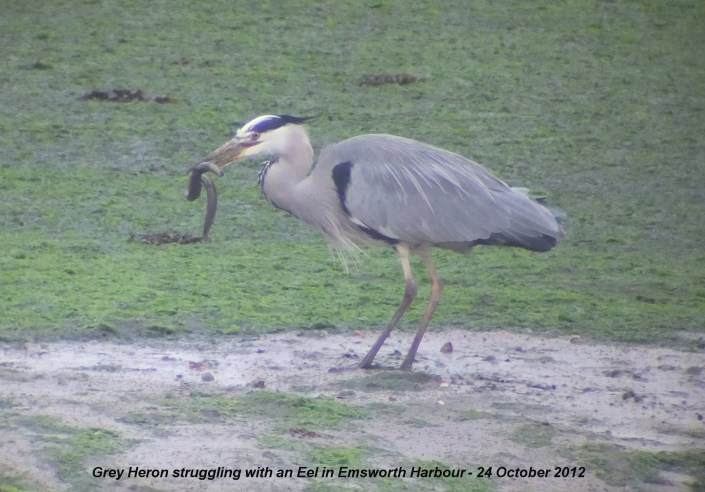
EMSWORTH
MILLPOND
Juvenile
Black-headed Gulls
Black-headed Gulls had
another very poor nesting season in Langstone Harbour.
I had a look through the 100 or so on the town
millpond this morning to see if there were any
juveniles. I found just five among them; they are easy
to pick out from the adults as they have gingery edges
to the wings. Unlike the larger gulls, Black-headed
Gulls only have one stage of juvenile plumage, so
there is no mistaking first winter birds.
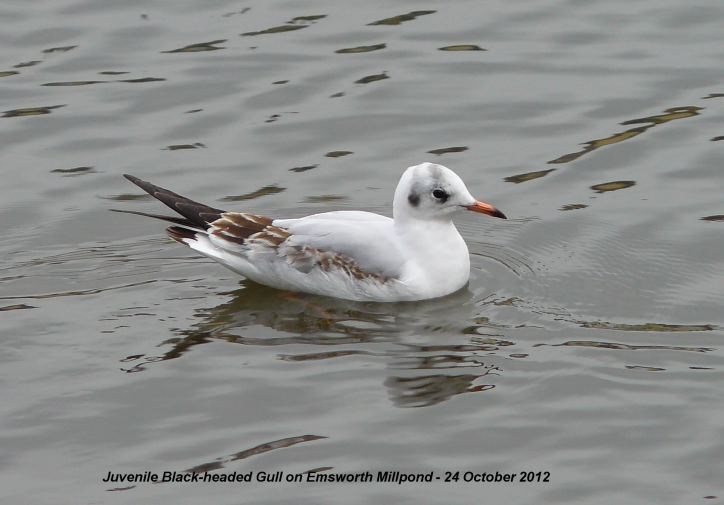
TUESDAY
OCTOBER 23 - 2012
CHICHESTER
Great
Tit song
Jean and I were in
Chichester this morning and parked in the multi-story
car park where we listened to at least one, and
possibly two, Great Tits in full song. This is the
second Great Tit song I have heard in the past week.
This must herald their autumn song.
Water
Bent
As we were walking
over the bridge from the top of the car park into
Chichester, I noticed some unusual grasses coming up
along the edge of the walkway. Grid Ref: SU 859044.

I confirmed them later
as Water Bent (Polypogon viridis), which I was
introduced to by John Norton and Eric Clement when
they visited Emsworth on June 4 this year. They found
it coming up through a crack in the pavement in the
driveway of 38 St James Road. I have subsequently
found it on the pavement outside 24 Victoria Road.
Cope and Gray (p.378)
state that Polypogon viridis occurs in the Channel Is
and Isles of Scilly and is scattered across Southern
England, especially below a line from the Bristol
Channel to the Thames. It is rare elsewhere in the
British Isles.
I checked the Sussex
Atlas and Polypogon viridis is recorded in SU80M.
New
Atlas
An annual or perennial
herb which is well-naturalised in the Channel Islands
on roadsides and by pools. In England it grows on tips
and damp waste ground, and is spreading as a weed of
nurseries, gardens and pavement cracks. Lowland.
Neophyte (change
+1.28). P. viridis was introduced into cultivation in
1800 and was first noted in the wild in Cardiff in
1876. It was recorded in Guernsey in 1897, and in
Jersey in 1906. It has spread in Jersey since the
1960s, and also appears to be increasing in England,
at least locally; for example, it was first recorded
in Somerset in 1989 and is now known from nine 10-km
squares.
EMSWORTH
HARBOUR
Emsworth
Harbour (east)
15:15 - 15:30 - Tide
rising to high water at 18:47 Ht 4.0.
Looking across the
main channel from the millpond seawall I could see
about 100 Black-tailed Godwits feeding on the far side
beneath the marina seawall. The light was not good and
they were too far away for me to read any
colour-rings. So I moved round to the western harbour
to see if any were there.
Emsworth
Harbour (west)
15:45 - 16:15 -
Mudflats were still completely exposed. I found 8
Black-tailed Godwits feeding close to the
Emsworth Sailing Club building and another 21 near to
Nore Barn.
Ther best sighting of
the afterboon were my first juvenile Brent
Geese; 4 adults and 4 juveniles were pootling
around in one of the low water channels. My guess is
that they were two broods of two juveniles, but I am
not sure.

With the low high
water still some way off, the stream was slow to fill
up and had no birds in it when I left at 4.15pm.
THORNEY
ISLAND
Short-eared
Owl
Tony Wootton went down
the Sussex side of Thorney today with his U3A bird
group and had lovely flying and perched views of a
Short-eared Owl. It was around the low bushes on the
far side of the Great Deeps near to the security gate.
This follows the report of five Short-eared Owls being
seen on Fowley island. So, this is a good time to see
one.
MONDAY
OCTOBER 22 - 2012
EMSWORTH
Tall Fescue is
out on the east side of Peter Pond, some with panicles
open and others with them closed. I have also seen it
out on Brook Meadow.

A Broad-leaved
Cockspur Thorn tree is growing in the front garden
of number 14 The Rookery. It is loaded with large red
berries. The only other one in the local area that I
am aware of is on the Westbourne Open Space wayside.
What I think is
Common Polypody is growing under the north side
of the north bridge on Brook Meadow. If confirmed this
would be a first for Brook Meadow.

LONG-TAILED
TITS
A 'charm' of about 20
Long-tailed Tits were feeding in the trees in my back
garden for about 5 minutes this morning. They were
constantly moving around and hardly stayed still for
more than a few seconds. And then they were gone! I
was lucky to get one shot that was reasonably in
focus. Long-tailed Tits are very infrequent visitors
to the garden; these were the first we have seen for
over a year.
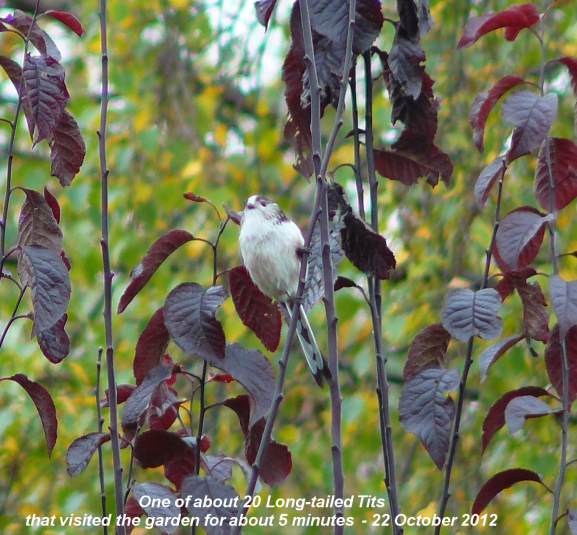
EMSWORTH
HARBOUR (WEST)
14:30 - 15:30 - Tide
rising to high water at 17:00.
Black-tailed
Godwits
There was a scattering
of godwits over the western mudflats when I arrived.
Some of them moved into Nore Barn Creek as the tide
came in, others flew off elsewhere. I counted just 26
in the Nore Barn area at 15:00, including two
colour-ringed birds:
WO+LW flag -
Regular over the past three winters in Emsworth. Our
3rd sighting this autumn.
ROL+RLR -
Regular over the past four winters in Emsworth. Our
4th sighting this autumn.
The
stream
Spotted
Redshank and Greenshank were feeding in the
stream from 15:00 to about 15:30 when the Spotted
Redshank flew off to the saltmarshes, apparently
chased by the Greenshank, which returned to the
stream. This is the second time I have seen this
happen this season. Strange, as they are usually so
tolerant of each other.
Others
28 Shelduck
were in the main channel. Ralph Hollins says these
waves of Shelduck passing through are likely to
continue to arrive until the end of December when
wintering numbers in the Solent harbours reach their
peak.
Still no increase in
Wigeon numbers with only 6 present this
morning. Ralph Hollins says a big wave of Wigeon
brought 850 to Pulborough Brooks on Oct 15 when he
first noticed 24 back in the mouth of the Langbrook
stream at Langstone.
SATURDAY
OCTOBER 20 - 2012
NEWS
FROM FINDHORN
It was good to hear
from Richard Somerscocks who moved to Findhorn in the
north of Scotland in the summer. Richard was an
important contributor to local wildlife news when he
lived in Emsworth and we all miss his beautiful
photos.
Here
is a view of Findhorn Bay

Well, he is back - at
least in spirit! Here is Richard's first ever report
from his new home town.
"You asked for the
occasional report with a photo or two, so here is a
bit of news from the north. I hadn't bothered up till
now because I didn't reckon that Findhorn could be
construed as local to Emsworth since it is over 600
miles away!
It was a gloriously
sunny day today so I had a good walk around Findhorn.
There was the usual group of Golden Plover in
the bay totalling 155 today. They tend to gather
together in quite a tight group - very similar to the
group that used to gather on the mudflats off Great
Deep. The ones here are much easier to photograph as
you can get somewhat closer.
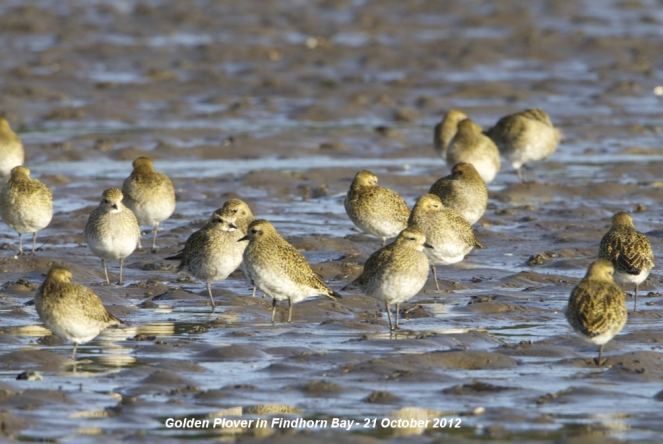
Whilst photographing
these a group of 6 Whooper Swans flew over. We
have had several in the bay along with the Mute Swans
for a few weeks now. The attached picture of the 2
Swans was taken a week or so ago.
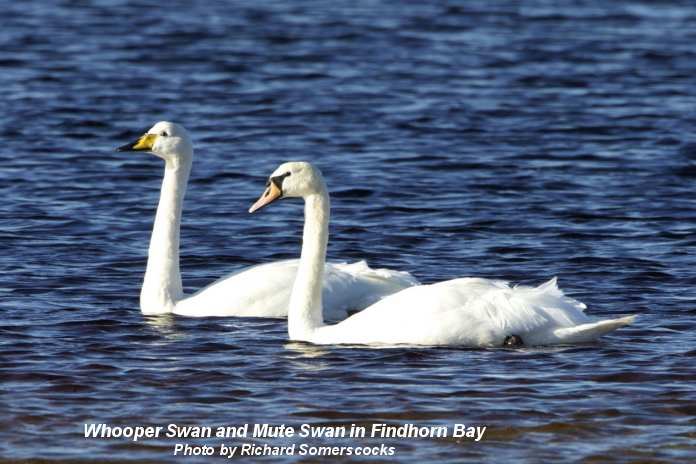
Offshore there were
plenty of Scoters as well as reasonable numbers of
Long-tailed Ducks.

Several people
reported a number of Dolphins off the beach
this afternoon but I missed them unfortunately,
although I do see them occasionally. The picture
attached was taken at Burghead about 7 miles along the
coast a few days ago. There are a reasonable number
living in the Moray Firth."

EMSWORTH
HARBOUR
Western
Harbour
12:30 - 13:30 - Tide
rising to high water at 15:25. The conditions were
perfect for birdwatching with no wind, calm sea and a
cloudy but reasonably bright sky.
Black-tailed
Godwits
I tracked a good flock
of Black-tailed Godwits as they gradually moved
westwards on the mudflats with the incoming tide. I
counted a maximum of 104 by about 13:00.
They included several
colour-ringed birds:
O+WL - 4th
sighting in Emsworth Harbour this autumn.
L+LL - First
sighting in Emsworth Harbour this autumn. L+LL was
regular in Emsworth over the past 3 winters. Last
winter it was recorded 25 times from 24-Sep-11 to
11-Feb-12.
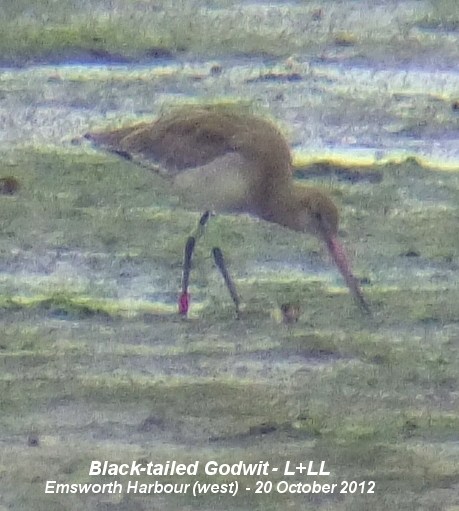
O+GB - First
sighting in Emsworth Harbour this autumn. A regular in
Emsworth Harbour last winter from 03-Dec-11 to
11-Feb-12.
R+GL - First
sighting in Emsworth Harbour this autumn. A regular in
Emsworth Harbour over the past two winters. Last
winter we had 14 sightings from 28-Sep-11 to
07-Dec-11.
ROL+RLR - 3rd
sighting in Emsworth Harbour this autumn. A regular in
Emsworth Harbour over the past three winters.
RYL+RLY - 2nd
sighting in Emsworth Harbour this autumn. A regular in
Emsworth Harbour over the past six winters.
The
stream
13:00 - All the
regular birds were feeding in the stream with Spotted
Redshank, Common Redshank, Greenshank and Little
Egret. The Spotted Redshank and Common Redshank flew
off at about 13:15 and the Greenshank went about 5
minutes later.
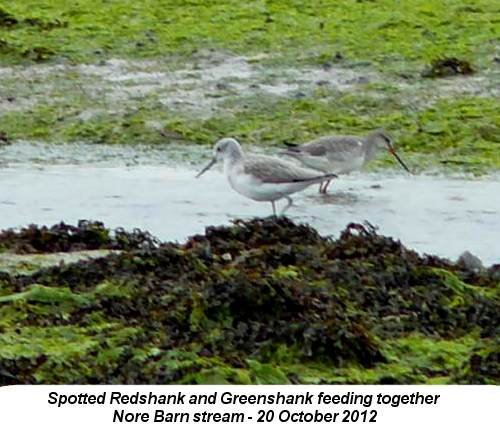
Other
observations
A large gathering of
about 130 Carrion Crows were on the mudflats -
presumably indicating a glut of food? About 50 Dunlin
were feeding on the edge of the main channel - the
first of the autumn in Emsworth.
BROOK
MEADOW
Water
Voles
Malcolm Phillips had a
walk round the meadow from 1pm till 2.30pm and was
lucky enough to see 2 Water Voles the first by the
north bridge and the second about 20yds south of the
sluice gate. He got a photo of the one near the sluice
gate as it was climbing the plants. These take the
total number of sightings for this year to 199. Shall
we get to the double century?
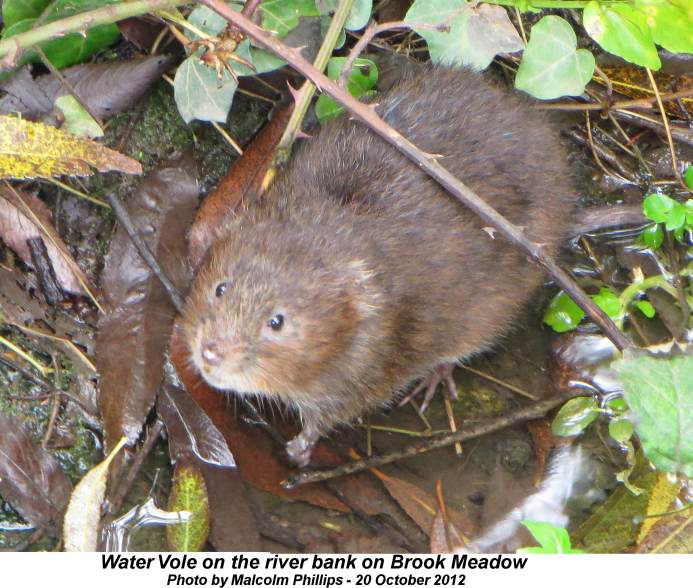
Goldfinches
Malcolm also saw a
couple of heavily moulting Goldfinches feeding north
of the north bridge.
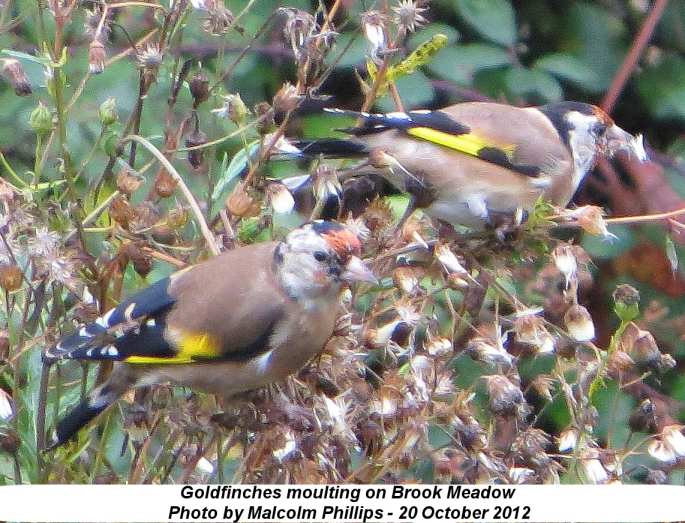
MYSTERY
FERNS
I have now
successfully cracked all the mystery ferns growing on
the North Street wall in Emsworth, thanks to help from
Martin Rand and Ralph Hollins. Following yesterday's
confirmation of Black Spleenwort, Martin has now
agreed that my other mystery is Male Fern (Dryopteris
filix-mas) with Wall-rue growing on the wall nearby.
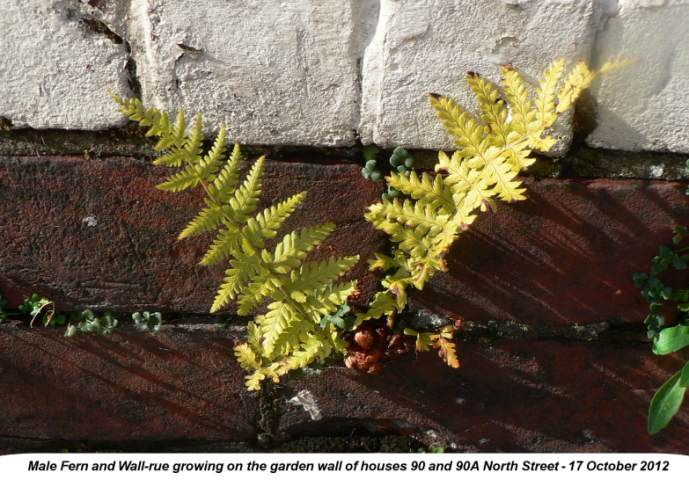
This wall almost
deserves a SINC designation with four fern species
growing on it: Male Fern, Wall-rue, Black Spleenwort
and Hart's-tongue.
Regarding the Black
Spleenwort (Asplenium adiantum-nigrum),
Martin says he has 3 post-Flora records in SU70, all
of them around Emsworth/Lumley and not too far away,
but the North Street record is a new one.
CAPTION
COMPETITION
Ralph Hollins provided
the following caption for the disputing House Sparrows
Nobody
told me to wash my hands before showing my love for
you, Tweety Pie!
(and I did not know I was passing on the deadly
Trichomonosis bacillus)

FRIDAY
OCTOBER 19 - 2012
NORE
BARN
12:00 - 13:00 - Tide
rising to high water at 14:37. The visibility was poor
with a constant light drizzle. The conditions were
very poor for photography.
Spotted
Redshank returns!
Good news - the
Spotted Redshank was back in the stream feeding with
its regular companions, Greenshank, Common Redshank
and Little Egret, after an absence of over a
week.
Here
are the Spotted Redshank and Common Redshank feeding
together
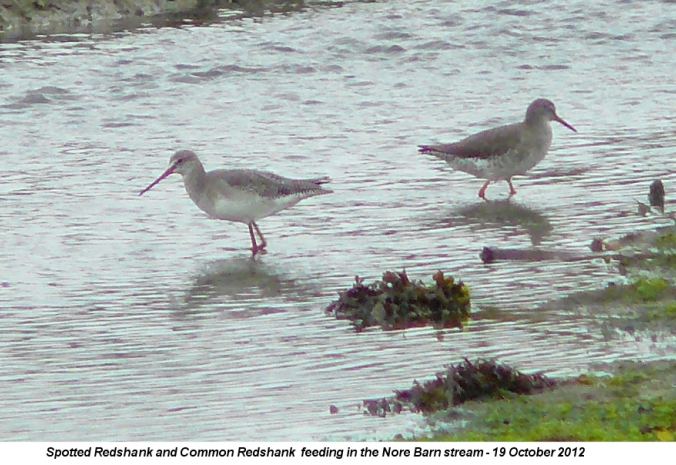
Here
is the Little Egret waiting for fish to come to
him

Also in the stream
were 5 Mute Swans, 4 Mallard and a Teal. A Cormorant
was fishing further out.
Black-tailed
Godwits
12:30 - 31
Black-tailed Godwits were feeding on the near shore of
Nore Barn Creek. They included three colour-ringed
birds, two of which were Kent ringed.
G+WR - Ringed
at Farlington on 10-Sept-08 as adult male. A regular
in Emsworth Harbour each winter since then. This was
our 8th sighting this autumn.
ROL+RLR -
Ringed on 27-Oct-08 at Kingsnorth Power Station,
Medway Est. Kent as an adult male. A regular in
Emsworth Harbour each winter. This was our 2nd
sighting this autumn.
RYL+RLY -
Ringed in Kent near Cliffe in autumn 2005 by Bill
Jones. A regular in Emsworth Harbour each winter since
2005. Our first sighting in Emsworth this autumn.
Usually arrives in early October, so it is a bit later
this year.
Here
is RYL RLY showing me its left leg - just in case I
had missed it!
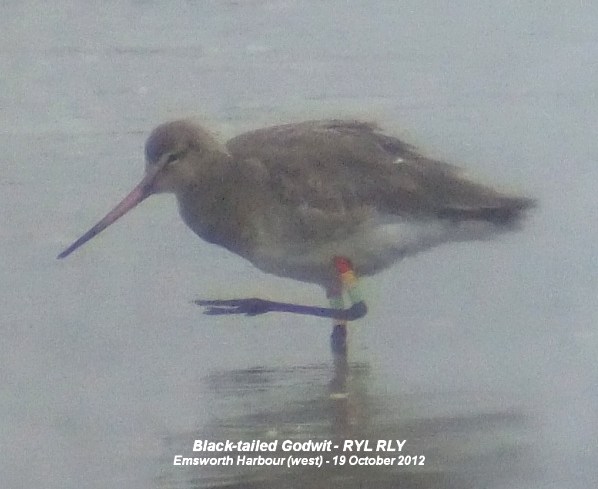
News
from Findhorn Bay
Richard Somerscocks
moved to Findhorn in the north of Scotland in the
summer. Richard was an important contributor to the
Godwit news when he lived in Emsworth and we all miss
him. I left him on the e-mail list for local news and
was delighted to get the following e-mail from him
today. I hope Richard can find the time to send us
more news from the 'frozen north', as well as some of
his wonderful photographs.
"Thanks
for all the news, although I am afraid I cannot
contribute much to the Godwit news from Findhorn in
the north of Scotland. I must admit I have been
keeping an eye on your website to find out what was
going on. I was glad to hear that the Spotted Redshank
has returned and I seem to remember from last year
that its sightings were a bit intermittent to begin
with, although a week with no sign of it is quite a
while.
Findhorn
Bay which is where I live has a fantastic amount of
birds overwintering. However there aren't many Black
tailed Godwit. The most I have seen is about 15 and I
haven't spotted any ringed birds yet. Common waders
include Redshank with about 400-500 at the moment,
Golden Plover (100+) and quite a lot of Knot and
Dunlin. Ringed Plovers breed here and there are about
30 Turnstone on the shore in front of my house.
The
most numerous birds though are the Pink-footed Geese.
At the 2-monthly bird count for the bay which we did
last weekend, we estimated that there were in excess
of 10,000, which is quite a spectacular sight. Large
numbers of Wigeon are also present. Offshore there are
good numbers of Long-tailed Ducks, Eiders and Scoters
both Common and Velvet.
Hope
you are all well and that it is bit warmer than the
frozen north. There is already quite a bit of snow on
the hilltops around here."
MYSTERY
FERNS
Black
Spleenwort
Martin Rand cleared up
one of the mystery ferns that I found growing on the
garden wall of numbers 90 and 90A North Street on
Wednesday October 17th. It is Black Spleenwort
(Asplenium adiantum-nigrum), which is a new
plant for me.
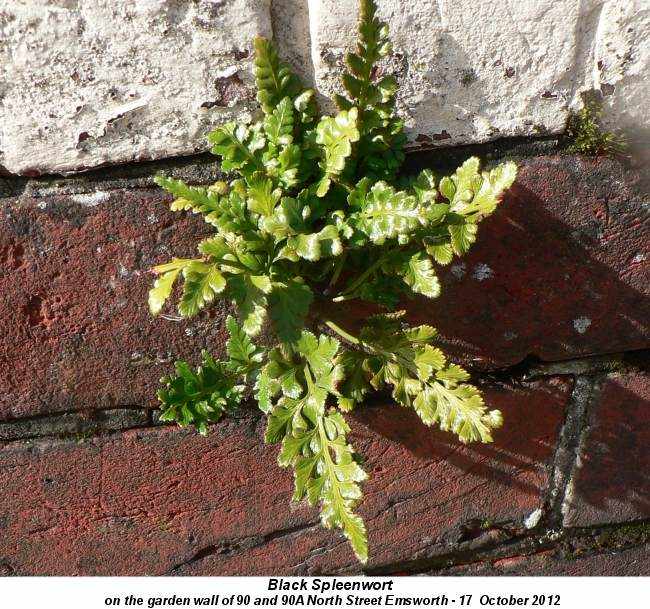
Here
is a view of the underside, showing the sori (spore
cases)
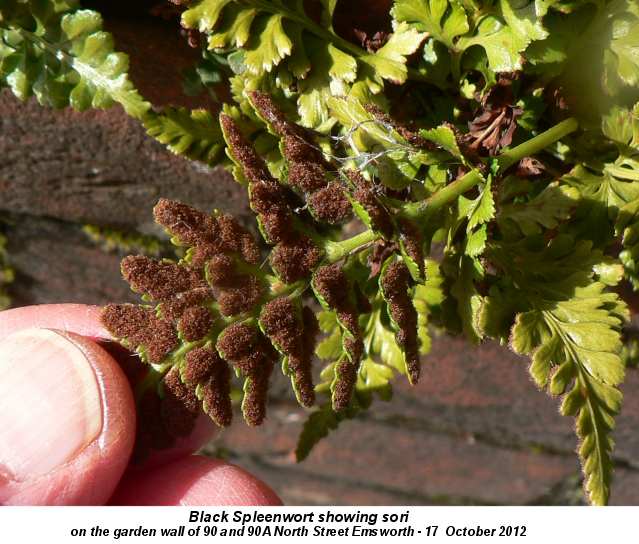
Ralph Hollins provided
me with a link to an excellent web site on ferns which
has a page of photos of Asplenium adiantum-nigrum
which closely match mine. See . . . http://www.ferns.rogergolding.co.uk/index.html
Black Spleenwort is
described as 'frequent' in The Hants Flora (p.95) on
walls, especially damp ones, and shady hedgebanks.
Surprisingly, it is not recorded in the 10km square
SU70. The site of the plants was at Grid Ref: SU
749063.
The New Atlas
describes Black Spleenwort as follows:
This evergreen perennial fern occurs on a wide range
of well-drained, usually basic substrates, in lightly
shaded habitats where there is little competition. It
is found on cliffs and screes, in quarries, on lane
banks and walls. Generally lowland, but reaching 575 m
at Moor House (Westmorland) and possibly higher in the
Cairngorms. Native (change +0.35). The distribution of
this species appears to be stable. European Temperate
element; also in C. Asia and N. America.
THURSDAY
OCTOBER 18 - 2012
EMSWORTH
Nutbourne
10:30 - Before going
to Nore Barn I had a quick look at Nutbourne Bay just
in case the Spotted Redshank had turned up there.
Plenty of Wigeon were in the bay along with a few
Brent Geese and Teal. A couple of Black-tailed Godwits
were feeding on the edge of the shore, but there was
no sign of the regular Greenshank (GY+GY) or the
Spotted Redshank in the stream.
Nore
Barn
11:00 11:30 - About 3
hours to high water. The tide was already well
advances and the stream filling up. The Greenshank was
feeding in the stream on its own. No Little Egret or
Spotted Redshank.

A flock of 54
Black-tailed Godwits gathered on the edge of the
saltmarshes in Nore Barn Creek. I checked most of them
for colour-rings, but did not find any.
Brook
Meadow
I had a stroll through
the meadow this afternoon. Very muddy underfoot.
A fine Red Admiral was
resting on the Michaelmas Daisies on the east side of
the Lumley area, along with a few Bombus pascuorum
bumblebees.

Wild Angelica was
flowering on the south meadow. There is a fresh growth
of Annual Meadow-grass at the start of the north west
path through the north meadow.
Slipper
Millpond
Eight Cormorants were
on the centre raft. An adult Great Black-backed Gull
was snoozing on the south raft, probably one of the
birds that nested here this summer.

GODWIT
NEWS
Anne de Potier counted
33 Black-tailed Godwits in Bosham Channel this morning
including three colour-ringed birds: RL+GL, which
historically favours that area, and G//R+BY, both just
north of the quay on the Bosham side. Also a new one
for the area, RGO+RNR, on the Chidham side almost
opposite. There were none at all at Fishbourne, which
is very surprising as that has been the best local
site for Black-tailed Godwits in previous years.
BRITISH
TRUST FOR ORNITHOLOGY NEWS
Swallows
leave it late
The BTO reports a
difficult year for Swallows. Many returned to the UK
later than normal this spring, having been held up by
poor weather further south. Now, some are setting off
late this autumn. They have reports of at least seven
nests still containing young in October, with one
brood fledging as late as 11 October. This is quite
unusual - of the 45,000 Swallow nest records collected
by the BTO Nest Record Scheme since 1939, only 16
Swallow nests have ever been recorded with chicks in
October.
See the reporting rate
at . . . http://bto-enews.org/IG4-ZADK-3RN36S-E29TI-0/c.aspx
Problems
for Pochard
The recent BTO Wetland
Bird Survey has revealed that numbers of wintering
Pochard in the UK have halved in the last 25 years.
The reason for this decline is uncertain, but climate
change it is thought that may be implicated. Numbers
of Ringed Plover have also fallen to an all time low.
For the report see . .
. http://bto-enews.org/IG4-ZADK-3RN36S-E09NN-0/c.aspx
Identifying
Dunlin and Knot
The BTO has produced a
useful video to help people distinguish between these
two small common waders. Go to . . . http://bto-enews.org/IG4-ZADK-3RN36S-E3B8Z-0/c.aspx
One feature I use
which the video does not emphasise is the different
feeding behaviour. Dunlin dart around like tiny wind
up toys feeding with a frenetic sewing machine action.
Knot are far more sedate feeders, pecking here and
there and not moving a great deal.
WEDNESDAY
OCTOBER 17 - 2012
EMSWORTH
Nore
Barn
10:30 - 11:00 I did my
usual check of the Nore Barn stream on a rising tide.
The Greenshank was feeding but there was no sign of
the Spotted Redshank. I did not stay due to rain and
high tide. The high spring tide produced the usual
flooding around Peter Pond and Dolphin Creek in
Emsworth.
Ferns
I had a close look at
the ferns growing on the garden wall of house numbers
90 and 90A just south of the entrance to Emsworth
Railway Station in North Street.

Hart's-tongue
Fern was an easy one to identify.

The others were not so
straight forward. The one on the south side of the
gate looked like Male Fern,

This one looked rather
like Wall Rue, but it clearly is not. I also
considered Rustyback

I also checked the
wall of the Waterside Church in Bath Road where the
unmistakable Maidenhair Spleenwort was looking
very fresh with ripe spore cases on the underside.

The Wall Rue on
the church wall was also in good shape

Albino
Common Comfrey?
Ralph Hollins
suggested that the white flowered Common Comfrey on
the river bank south of the S-bend in the river on
Brook Meadow (see entry for Oct 12) might qualify as a
'very rare albino' form of the plant. Stace's Flora
says .. "The flowers (of Common Comfrey) are often
wrongly described as white but except for very rare
albinos they are pale creamy yellow or purplish".

I asked Martin Rand if
this was possible. He was not persuaded by Stace's
argument. "If the wings are decurrent well beyond the
next leaf junction, and if the ripe seeds are shiny
and not minutely warty, then it's S. officinale
(Common Comfrey) and there's nothing else it can be.
'Real' albino plants in the Boraginaceae family
usually also have yellowish-green leaves, and yours
don't. When the flowers are in bud or very freshly
opened it's true they are usually cream (but sometimes
a gorgeous wine-red in bud!), but later on I think
they're often more white than cream."
OTHER
NEWS
Silver
Y moth
Mike Wells sent me
this photo of a Silver Y moth in his garden in
Cowplain. Mike says, it is classed as a frequent
migrant, but it is the first one he has seen. He has
informed the Hants Moth Recorder who has recorded the
sighting.

Caption
competition
Lesley Harris sent me
this sweet photo of a pair of House Sparrows disputing
over some food item. Lesley says it is doing the
rounds on the internet and suggests a caption
competition. The original caption was "When a Male
Bird can't stand it anymore". Lesley prefers "I don't
want you dropping off the perch". Any other offers?

For earlier observations go to . . . October
1-15